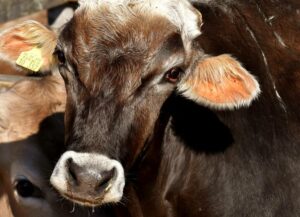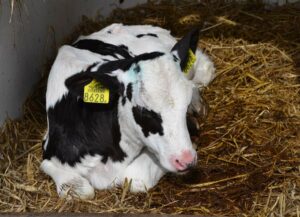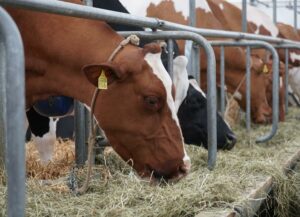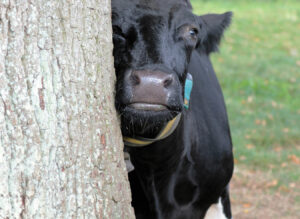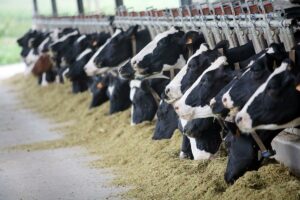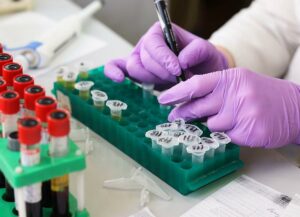María Villagrasa & Nuria García
Displaced abomasum (DA) is an alteration of the digestive tract of ruminants that causes huge economic losses due to the reduction in milk production, treatment costs and death or slaughter of cows.
Most DAs occur to the left and once detected the abomasum should be repositioned back to normal, that is, on the floor of the abdominal cavity. One of the methods used to correct DAs is laparoscopic abomasopexy, a minimally invasive and fast technique with which the need to administer antibiotics is reduced.
Performing abomasum surgery
The most common technique in abomasopexy procedures consists of two steps: the first is performed with the animal standing, while in the second, the cow is placed in dorsal decubital position, either by laying down or using a specially designed table on the incline called a tilting table. One of the problems with using this table is that it causes an increase in blood cortisol, an important stress indicator, it is thus advisable to apply analgesia protocols during interventions that may be painful or stressful.
Cortisol has also traditionally been used as indicator of fear and pain, but in recent years research has focused on substance P as a more objective indicator of pain in livestock.
Animals that undergo laparoscopic abomasopexy usually do not receive sedation, but administration of an alpha-2-antagonist, such as xylazine, which reduces stress and cortisol concentrations in animals that lie on their side.
A recent study (Tschoner et al., 2020) has focused on describing changes in plasma concentrations of cortisol and substance P during and after laparoscopic abomasopexy with or without xylazine administration to assess whether there were adverse effects during surgery. The authors also evaluated behavioral patterns, as well as feeding and ruminating times during and after surgery.
The study included a total of 28 cows with left DA of the German Simmental (n=23), Holstein Friesian (n = 4) and Brown Swiss (n = 1) breeds. Cows had to be at least of second parity.
Cows were randomly assigned to one of the following groups:
- Control: 0.02 mg/kg saline solution (0.9%)
- Xylazine: 0.02 mg/kg BW of xylazine
The substances were administered intravenously 15 minutes before the skin incision. Local anesthesia was performed with 10 ml of procaine hydrochloride. To determine the baseline concentration of cortisol and substance P (00:00 h) blood was drawn on the day of surgery 180 minutes before its start. The start of the surgery was defined as the time of the application of local anesthesia on the left flank (+03:00 h). More blood samples were drawn at 15, 30, 45, 60, 90, 120 and 180 min and 24 hours after surgery started.
The abomasopexy was performed by a surgeon in a 180-degree hydraulic tilt. Each cow was placed against the tilting table on its right side. The surgeon then secured his head and tied the animal to the table with a chest and abdominal belt. The timing of the administration of the local anesthetic was defined as the onset of surgery, and the skin incision was made with the cow standing. The table was then moved until the cow was placed first in lateral decubital and then dorsal.
Cortisol concentration was lower in animals receiving xylazine
The plasma concentration of mean basal cortisol was 22.0 ng/ml in the control group and 16.0 ng/ml in the xylazine group. The main results were as follows:
- Animals that received xylazine prior to surgery showed a significantly lower cortisol concentration than 15 and 30 minutes after surgery compared to the control group.
- Animals in the control group showed a significant increase in the concentration of cortisol 45 (dorsal decubital position), 60 (end of surgery) and 90 min after initiation of surgery compared to the onset of surgery.
- The concentration of cortisol in the xylazine group was lower at all sampling times on day 1 compared to the control group, and significantly less than 3.5 h later.
These results indicate that animals experience less stress during abomasopexy after administration of xylazine, especially before being placed in lateral decubitus and subsequently remaining in dorsal decubitus.
Substance P and time spent ruminating
With regards to substance P, the average basal concentration was 555.3 pg/ml in the control group and 490.6 pg/ml in the xylazine cows. No significant differences were observed between groups at any time. No significant differences in cow behavior were observed during surgery (ear movement, head…) and the next two days (activity, head position, ears, vocalizations…).
When analyzing the time spent eating or ruminating, no differences were observed between both groups. However, with regards to the number of chews per bolus, previous studies indicate healthy animals have an average of 55, a figure similar to that obtained in this study in the xylazine group (55.5) and different from the control group (46.6).
Conclusion
These data indicate that cows treated with xylazine before abomasopexy experience less stress during and after surgery than animals not treated with xylazine. For this reason, the authors recommend its administration at a low dose (0.02 mg/kg) in combination with a nonsteroidal anti-inflammatory and a local anesthetic to improve animal well-being during and after surgery.
Reference
Tschoner, Theresa & Zablotski, Y. & Knubben-Schweizer, Gabriela & Feist, M. (2020). Effect of xylazine administration before laparoscopic abomasopexy to correct left displaced abomasum on markers of stress in dairy cows. Journal of Dairy Science. 103. 10.3168/jds.2020-18523.
© 2020 Dairy Knowledge Center. All Rights Reserved.


